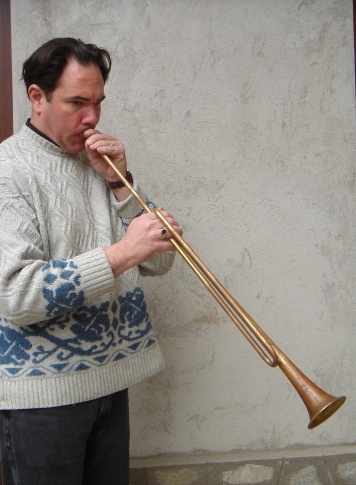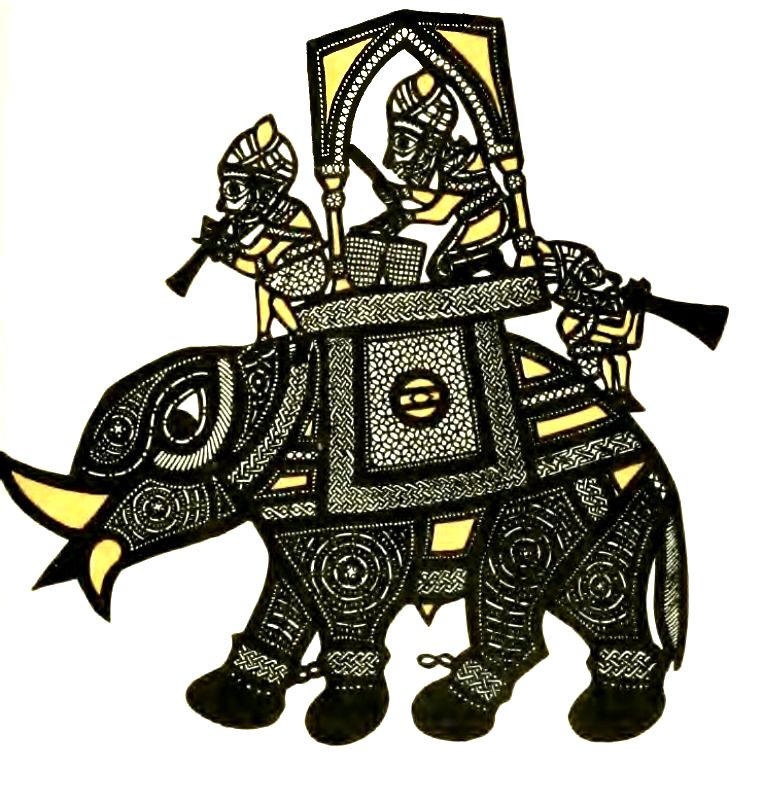|
Clarion (instrument)
Clarion is a name for a high-pitched trumpet used in the Middle Ages and the Renaissance. It is also a name for a 4' organ reed stop that produces a high-pitched or clarion-like sound on a pipe organ in the clarion trumpet's range of notes. The word ''clarion'' has changed meanings over centuries and across languages. Today, in modern French'' clairon'' refers to the bugle, while in Italy '' chiarina'' refers to modern trumpets of historic design, made from bent tubing and without valves, similar to the natural trumpet. Resembling these instruments is the modern fanfare trumpet, like the ''chiarina'' or natural trumpet, but with the option of using valves. ''Clarion'' became a musical term to refer the upper register of the standard trumpet. However, a ''clarin'' trumpet did exist with a narrower bore than the standard trumpet and a "broad, flat mouthpiece," designed to "play the high partials." In war the trumpet historically had a harsh sound, often described as, "like the ... [...More Info...] [...Related Items...] OR: [Wikipedia] [Google] [Baidu] |
Slide Trumpet
The slide trumpet is an early type of trumpet fitted with a movable section of telescopic tubing, similar to the slide of a trombone. Eventually, the slide trumpet evolved into the sackbut, which evolved into the modern-day trombone. The key difference between these two instruments is that the slide trumpet possesses only a ''single'' slide joint, rather than the two joints in the U-shaped slide of the sackbut or trombone. There are several types of slide trumpet of different places and eras. Early instrument The slide trumpet grew out of the war trumpet as used and developed in Western and Central Europe: Don Smithers argues that the slide grew out of the detachable leadpipe, and separated the use of the trumpet as a dance instrument from the trumpet as a signaling device in war. Renaissance slide trumpet :''See: Clarion'' As no instruments from this period are known to have survived, the details—and even the existence—of a Renaissance slide trumpet is a matter of some ... [...More Info...] [...Related Items...] OR: [Wikipedia] [Google] [Baidu] |
Don Randel
Don Michael Randel (born December 9, 1940) is an American musicologist, specializing in the music of the Middle Ages and Renaissance in Spain and France. He is currently the chair of the board of the American Academy of Arts and Sciences, a trustee of the Carnegie Corporation, and a member of the Encyclopædia Britannica editorial board, and has previously served as the fifth president of the Andrew W. Mellon Foundation, as 12th president of the University of Chicago from 2000 to 2006, Provost of Cornell University, and Dean of Cornell's College of Arts and Sciences. He has served as editor of the third and fourth editions of the ''Harvard Dictionary of Music'', the ''Harvard Biographical Dictionary of Music'', and the ''Harvard Concise Dictionary of Music and Musicians''. He was elected to the American Philosophical Society in 2002. Randel is a triple alumnus of Princeton University, where he earned his bachelor's, master's and doctoral degrees in musicology. After completing ... [...More Info...] [...Related Items...] OR: [Wikipedia] [Google] [Baidu] |
Karnay
The karnay or kerana is a metal natural trumpet. The name is first mentioned in the biblical book of Daniel, used in the Middle Ages to the Persian military bands and in the Indian Mughal Empire to the representative orchestra naqqāra-khāna and which is still used by this name in ceremonial music in Central Asia and northern India. Since the middle of the 3rd millennium B.C., trumpets known in both Mesopotamia and Ancient Egypt were used in both regions as signaling instruments in ceremonies, warfare and work assignments. They could only produce one or two notes, but could send messages using patterns of rhythm. ''Karnā'' derives from Aramaic ''qarnāʾ'', Hebrew ''qeren'' and Akkadian ''qarnu''. In addition to the Arabic word ''būq'' for brass instruments in general (horns and trumpets), in medieval Arabic texts '' nafīr'' predominantly referred to a slender, cylindrical, shrill-sounding metal trumpet, ''būq'' a slightly shorter, conical trumpet and ''karnā'' a conical, ... [...More Info...] [...Related Items...] OR: [Wikipedia] [Google] [Baidu] |
Nafir
''Nafir'' (Arabic نَفير, DIN 31635, DMG ''an-nafīr''), also ''nfīr'', plural ''anfār'', Turkish ''nefir'', is a slender shrill-sounding straight natural trumpet with a cylindrical tube and a conical metal bell, producing one or two notes. It was used as a Signal instrument, military signaling instrument and as a ceremonial instrument in countries shaped by Islamic culture in North Africa, the Middle East and South Asia. In Ottoman, Persian and Mugulin miniatures, the ''nafīr'' is depicted in battle scenes. In Christian culture, it displaced or was played alongside of the curved tuba or horn, as seen in artwork of about the 14th century A.D. Similar straight signal trumpets have been known since ancient Egyptian times and among the Assyrians and Etruscans. After the fall of the Roman Empire, the straight-tubed Roman tuba continued to flourish in the Middle East among the Sassanids and their Arabic successors. The Saracens, whose long metal trumpets greatly impressed the ... [...More Info...] [...Related Items...] OR: [Wikipedia] [Google] [Baidu] |
Añafil
The ''buisine'' and the ''añafil'' were variations of a type of straight medieval trumpet usually made of metal, also called a herald's trumpet. While arguably the same instrument, the two names represent two separate traditions, in which a Persian-Arabic-Turkic instrument called the ''Nafir'' entered European culture in different places and times. The term ''buisine'' (Old French; also, ''busine'', ''buysine'', ''buzine'') descends from ''Buccina'', a Roman military horn. The horn was mainly used for military and ceremonial purposes. When Europeans went to the crusades, the instrument was seen as a proper military target (in the same way a flag or pendant was), something to capture and bring home. The term ''añafil'' descends from '' al-Nafir'', the Persian-Arab Islamic trumpet which was used by Moorish armies in Spain, before the Crusades. By the Reconquista (722–1492) when residents of the future Spain retook the Iberian Peninsula, ''añafil'' was part of the nation's lan ... [...More Info...] [...Related Items...] OR: [Wikipedia] [Google] [Baidu] |
Donkey
The donkey or ass is a domesticated equine. It derives from the African wild ass, ''Equus africanus'', and may be classified either as a subspecies thereof, ''Equus africanus asinus'', or as a separate species, ''Equus asinus''. It was domesticated in Africa some years ago, and has been used mainly as a working animal since that time. There are more than 40 million donkeys in the world, mostly in underdeveloped countries, where they are used principally as Working animal, draught or pack animal, pack animals. While working donkeys are often associated with those living at or below subsistence, small numbers of donkeys or asses are kept for breeding, as pets, and for livestock protection in developed countries. An adult male donkey is a ''jack'' or ''jackass'', an adult female is a ''jenny'' or ''jennet'', and an immature donkey of either sex is a ''foal''. Jacks are often mated with horse, female horses (mares) to produce ''mule, mules''; the less common hybrid of a stalli ... [...More Info...] [...Related Items...] OR: [Wikipedia] [Google] [Baidu] |
Grenville Arms, Bench End, SutcombeChurch, Devon
Grenville may refer to: People British Prime Ministers * George Grenville (1712–1770), Prime Minister 1763–1765 * William Grenville, 1st Baron Grenville (1759–1834), his son, Prime Minister 1806–1807 Other people * Anne Grenville, Baroness Grenville (1772–1864), English noblewoman and author * Bevil Grenville (1596–1643), English soldier * Bruce Grenville (Bruce Ronald Henderson, born 1950), New Zealand anarchist and hoaxer * Elizabeth Grenville (1719–1769), British artist and writer * George Grenville (other) * Georgina Grenville (born 1975), South African fashion model * Henry Grenville (1717–1784), British diplomat and politician * Hester Grenville, 1st Countess Temple, (c. 1690 – 1752) * Honor Grenville, Viscountess Lisle, (c. 1493–5 – 1566) * Kate Grenville (born 1950), Australian author * James Grenville (1715–1783), British politician * James Grenville, 1st Baron Glastonbury (1742–1825), British politician * Jane Grenville (born 1958) ... [...More Info...] [...Related Items...] OR: [Wikipedia] [Google] [Baidu] |
Partial (music)
The harmonic series (also overtone series) is the sequence of harmonics, musical tones, or pure tones whose frequency is an integer multiple of a ''fundamental frequency''. Pitched musical instruments are often based on an acoustic resonator such as a string or a column of air, which oscillates at numerous modes simultaneously. As waves travel in both directions along the string or air column, they reinforce and cancel one another to form standing waves. Interaction with the surrounding air produces audible sound waves, which travel away from the instrument. These frequencies are generally integer multiples, or harmonics, of the fundamental and such multiples form the harmonic series. The fundamental, which is usually perceived as the lowest partial present, is generally perceived as the pitch of a musical tone. The musical timbre of a steady tone from such an instrument is strongly affected by the relative strength of each harmonic. Terminology Partial, harmonic, f ... [...More Info...] [...Related Items...] OR: [Wikipedia] [Google] [Baidu] |
Fanfare Trumpet
A fanfare trumpet, also called a herald trumpet, is a brass instrument similar to but longer than a regular trumpet (tubing is the same length as a regular Bb trumpet but not wrapped), capable of playing specially composed fanfares. Its extra length can also accommodate a small ceremonial banner that can be mounted on it. It differs from its precursor, the medieval buisine, by being coiled rather than straight, and from the clarion trumpet and natural trumpet by possibly having valves. Historical background Fanfare trumpet-like instruments existed in ancient Rome (like the Roman tuba), while Iran, Korea and China sport similar traditional instruments ('' karnay'', '' nafir'', '' nabal'' and ''laba'' in the latter three). Beginning in the late Middle Ages, straight herald trumpets (known as the buisine) and later coiled valve-less natural trumpets, clarions and drums (usually snares and tenors) would sound fanfares to mark important holidays or ceremonial events. ... [...More Info...] [...Related Items...] OR: [Wikipedia] [Google] [Baidu] |
Natural Trumpet
A natural trumpet is a valveless brass instrument that is able to play the notes of the harmonic series. History :''See: Clarion'' The natural trumpet was used as a military instrument to facilitate communication (e.g. break camp, retreat, etc.). Even before the late Baroque period the natural trumpet had been accepted into Western art music. There is evidence, for example, of extensive use of trumpet ensembles in Venetian ceremonial music of the 16th century. Although neither Andrea nor Giovanni Gabrieli wrote music specifically for the trumpet, they would have been very familiar with its technical possibilities. Later, talented players such as the early baroque composer Girolamo Fantini demonstrated that by playing in the extreme upper register and "lipping" the notes of the 11th and 13th harmonics (that is, flattening or sharpening those impure harmonics into tune with the embouchure), it was possible to play diatonic major and minor scales (and, hence, actual melodie ... [...More Info...] [...Related Items...] OR: [Wikipedia] [Google] [Baidu] |
Bugle
The bugle is a simple signaling brass instrument with a wide conical bore. It normally has no valves or other pitch-altering devices, and is thus limited to its natural harmonic notes, and pitch is controlled entirely by varying the air and embouchure. History :''See also Clarion'' and ''Natural trumpet'' The English word ''bugle'' comes from a combination of words. From French, it reaches back to ''cor buglèr'' and ''bugleret'', indicating a signaling horn made from a small cow's horn. Going back further, it touches on Latin, ''buculus,'' meaning bullock. Old English also influences the modern word with ''bugle'', meaning "wild ox." The name indicates an animal's (cow's) horn, which was the way horns were made in Europe after the fall of the Western Roman Empire. The modern bugle is made from metal tubing, and that technology has roots which date back to the Roman Empire, as well as to the Middle East during the Crusades, where Europeans re-discovered metal-tubed trum ... [...More Info...] [...Related Items...] OR: [Wikipedia] [Google] [Baidu] |






